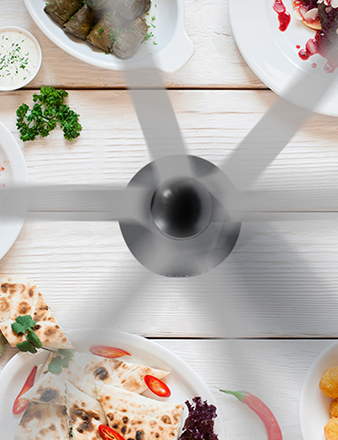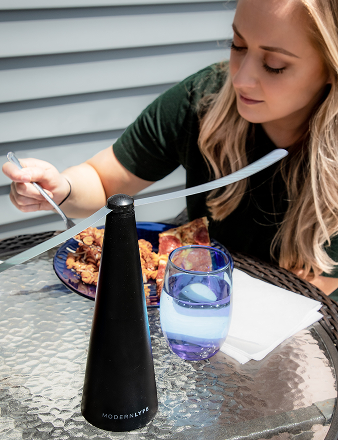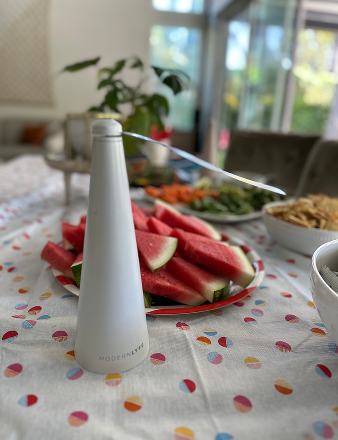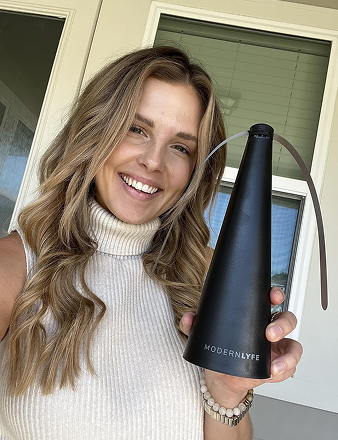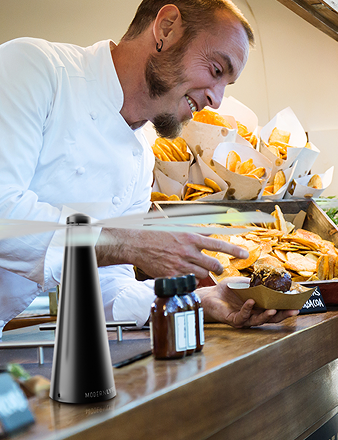Flies are a direct threat to your restaurant's reputation. Fly fans offer a simple, chemical-free solution to keep your space clean. By creating a continuous stream of air, they form an invisible barrier that flies can't cross—perfect for protecting doorways, patios, and service windows without disrupting your guests.
Creating a Fly-Free Dining Experience
A single fly can ruin a great meal and make customers question your restaurant's cleanliness. As carriers of bacteria and pathogens, flies pose a serious food safety risk that can damage the reputation you've worked hard to build.
Traditional methods like zappers and chemical sprays often create more problems. Zappers are noisy and unsanitary, while sprays introduce chemical smells and the risk of contaminating food.
Fly fans are a smarter solution. Instead of attracting or killing flies, they create an environment where flies simply can't fly.
The concept is simple: a consistent, downward airflow disrupts a fly's flight pattern. To your guests, it's a gentle breeze. To a fly, it's an impassable wall, effectively sealing off your dining area without chemicals or noise.
The Modern Solution for Restaurant Hygiene
As diners become more aware of cleanliness, restaurants need smarter, safer solutions. The industrial fan and blower market, which includes commercial fly fans for restaurants, generated over USD 10.6 billion globally.
With the market projected to grow by more than 4.3% annually, it’s clear that businesses are prioritizing sanitation and customer comfort.
Here’s what installing fly fans can do for your restaurant:
- Boost Food Safety: Keep flies away from food prep surfaces, dining tables, and service counters.
- Elevate Customer Comfort: Let guests enjoy their meal in peace, especially on outdoor patios, without swatting at pests.
- Strengthen Your Brand: Show a clear commitment to a clean, pest-free dining area to build trust and encourage repeat business.
Adopting this modern approach is one of the most effective ways to protect your establishment. For a deeper dive into pest management, check out our guide on fly control for restaurants. It covers everything you need to know to select and position the perfect fly fan for your business.
Why Old Fly Control Methods Don't Work
Using outdated fly control methods in your restaurant is like using a rotary phone for reservations. They might work, but they're inefficient and create a bad impression. Traditional tools can do more harm than good to the dining experience you've worked so hard to create.
Take the classic bug zapper. The loud ZAP! is the last thing a customer wants to hear. Even worse, research shows that zappers can cause insects to explode, sending contaminated particles through the air—a major hygiene risk near a kitchen or dining room.
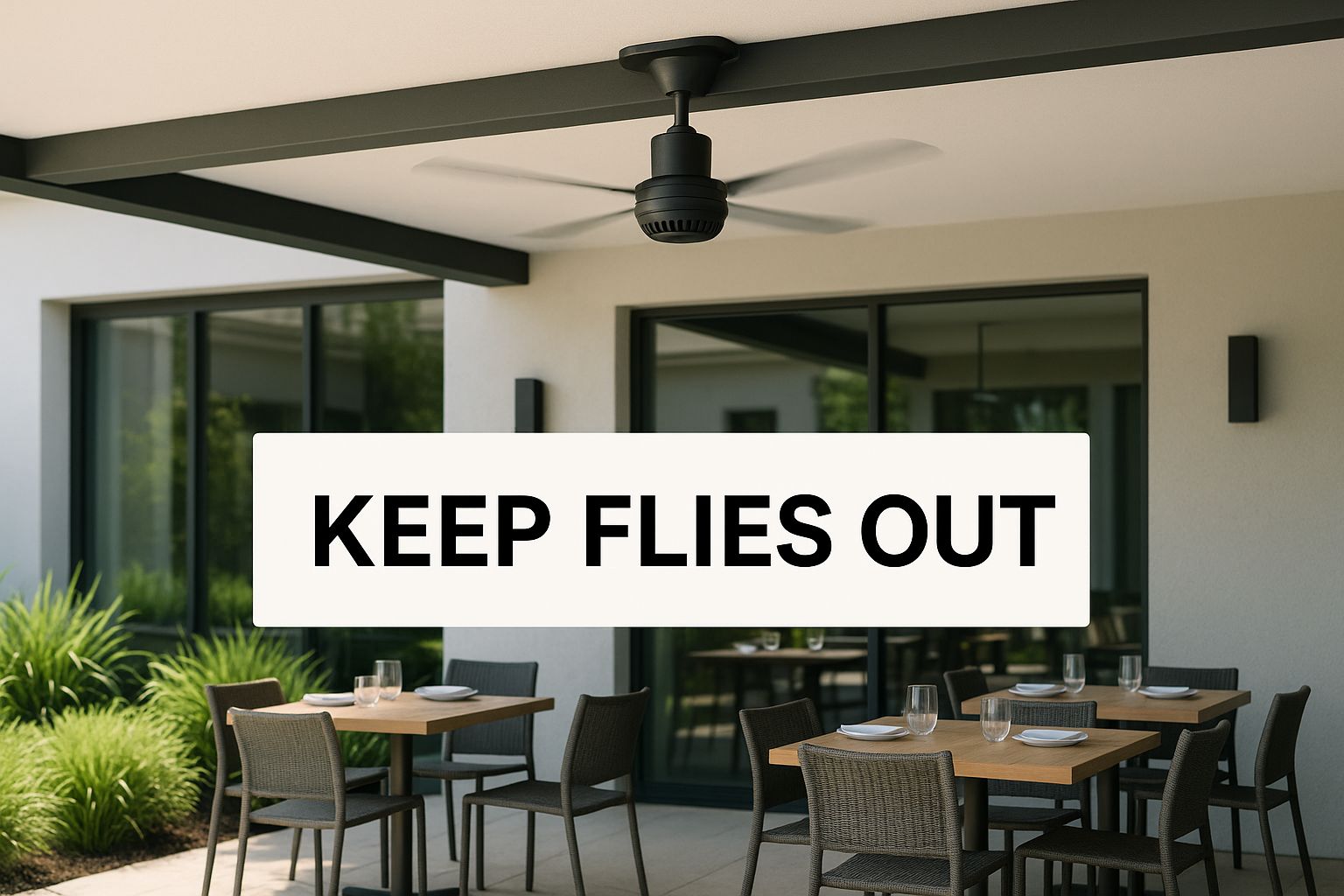
Modern solutions like fly fans for restaurants are designed to work with your environment, not against it. They create a seamless, invisible shield to keep pests out without anyone noticing.
The Problem with Traps and Sprays
Sticky traps aren't much better. They catch a few flies but quickly become a disgusting display of dead insects. It's an eyesore that signals a fly problem to your customers. Once they're full, they're useless until someone remembers to replace them.
Chemical sprays present another set of problems.
The idea of aerosolized poison drifting over food, clean plates, or a customer's meal is a nightmare for any restaurant owner. Even without direct contamination, the lingering chemical smell clashes with the aromas from your kitchen and makes the space feel cheap and unclean.
These outdated methods are reactive. They deal with flies after they're already inside, introducing new issues like noise, unsightly messes, and health risks.
Comparing Fly Control Methods for Your Restaurant
Not all fly control solutions are suitable for a food service environment. Your choice directly impacts your guests' experience and your restaurant's reputation. Here’s a quick comparison of the options.
| Method | Effectiveness | Hygiene Risk | Guest Impact | Best For |
|---|---|---|---|---|
| Fly Fans | High | None | None (discreet) | Proactively preventing entry at doorways and pass-through windows. |
| Bug Zappers | Moderate | High (airborne contaminants) | High (noisy, jarring) | Outdoor, non-food areas far from guests. |
| Sticky Traps | Low to Moderate | Low | High (unsightly) | Back-of-house monitoring, away from customer view. |
| Chemical Sprays | Moderate | High (food contamination) | High (unpleasant odor) | Emergency use only, when the area can be cleared and cleaned. |
As the table shows, older methods come with significant trade-offs that aren't worth it for a modern restaurant. They're a temporary fix at best.
It's Time for a Modern Approach
The hidden cost of outdated tools isn't just the price of traps or sprays; it's the potential damage to your reputation. One bad review mentioning a zapper's noise or a chemical smell can cost you far more in the long run.
This is why fly fans are a smart investment. Instead of reacting to pests that have already invaded your space, they stop them at the door. They use a simple, chemical-free curtain of air that flies can't penetrate. It’s a proactive strategy that protects your food, your customers, and your restaurant's ambiance.
The Business Benefits of Installing Fly Fans
Installing fly fans in your restaurant is a smart business decision that directly improves customer satisfaction, safety, and brand perception. While their primary function is keeping flies out, the positive effects are felt throughout your entire operation.
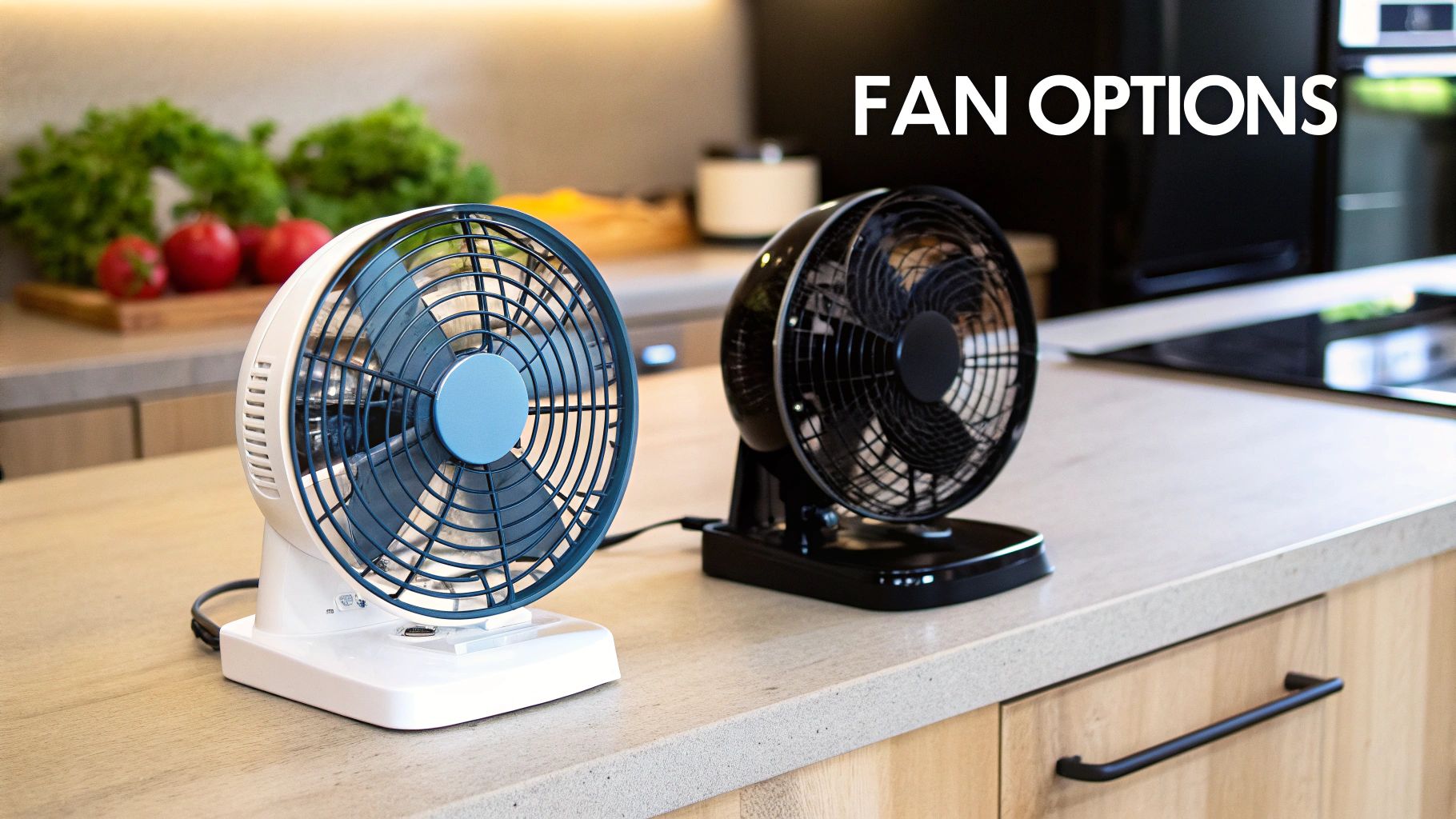
You'll see an immediate improvement in food safety and hygiene. Flies are known carriers of germs. Preventing them from landing on food or prep surfaces is your best defense against contamination and is far more effective than dealing with pests once they're inside.
Enhance the Customer Experience
A diner's comfort is crucial. You can create the perfect atmosphere, but a single fly can ruin it. By placing fly fans over entrances and patios, you protect the entire dining experience.
Guests can relax and enjoy their food without swatting at insects. This simple addition transforms a potentially annoying meal into a pleasant one. It demonstrates your high standards and attention to detail, which leads to positive reviews and loyal customers. You can learn more about how different models achieve this in our overview of commercial fly fans.
A pest-free environment isn't a luxury—it's an expectation. Fly fans keep the focus on your excellent food and service, not on annoying insects.
Strengthen Your Brand with a Sustainable Choice
Today, customers care about the health and environmental impact of the businesses they support. Choosing fly fans for restaurants shows you're a modern, responsible establishment that prioritizes safety without relying on harsh chemicals.
This aligns with what consumers want. As hygiene awareness has grown, so has the demand for eco-friendly solutions. In fact, 58% of consumers now prefer green pest control methods like fly fans. This proves that going chemical-free not only keeps your guests safe but also enhances your brand's appeal.
Their quiet, seamless operation won't disrupt your restaurant's atmosphere. The gentle airflow is barely noticeable, so your guests will only remember the quality of their meal and the great experience.
How to Choose the Right Fly Fan for Your Space
Selecting the right fly fan means matching the tool to the specific needs of your restaurant's layout. A fan that works for a small pickup window won't be effective for a large patio entrance. Making the right choice ensures you get the pest protection you need.
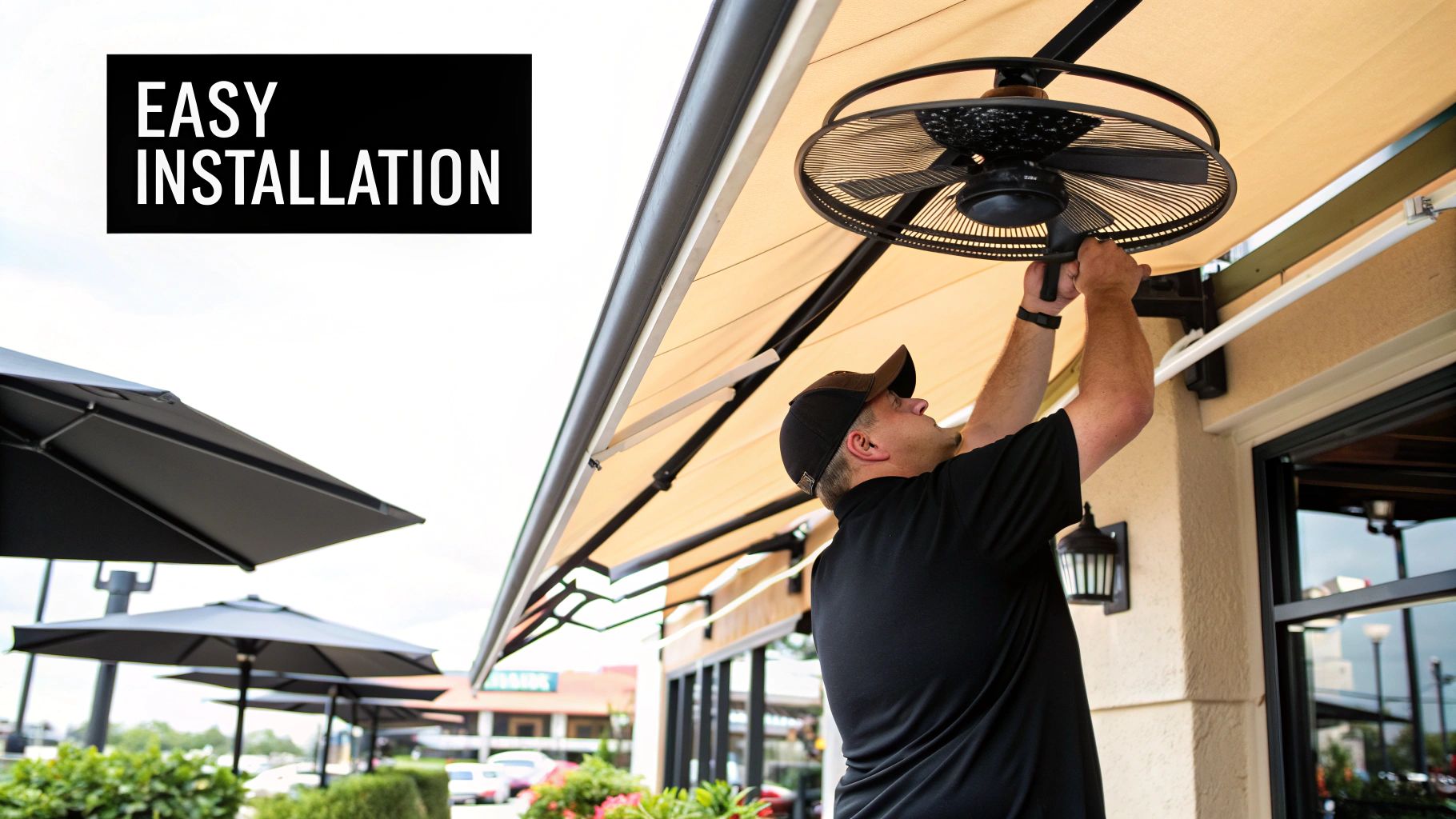
Start by identifying the areas you need to protect. High-traffic main doors, kitchen back doors, and breezy outdoor dining areas each present unique challenges. By understanding a few key features, you can confidently choose fly fans for restaurants that work exactly where you need them.
Decode the Power: CFM and Air Speed
The most important specification is CFM, or Cubic Feet per Minute. CFM measures the volume of air the fan moves. A higher CFM means more air is pushed downward, creating a wider and stronger barrier. This is essential for large openings like double doors or patio perimeters.
But CFM is only part of the story. You also need to consider air speed, measured in Feet per Minute (FPM). While CFM indicates the amount of air, FPM measures its force. High FPM ensures the air curtain is strong enough to reach the floor and physically block flies, even on windy days.
For a standard restaurant doorway, you'll want a fan that delivers an air stream of at least 1,600 FPM measured three feet from the floor.
Match the Fan to Your Space
The type of fan you choose depends entirely on its location. Different models are designed for different applications, and a proper match is key to effective performance.
-
Entrances and Main Doors: These are your primary defense. Use powerful, heavy-duty fans. Wall-mounted "air curtain" units that span the full width of the door are ideal, creating a solid wall of air.
-
Patios and Outdoor Seating: For outdoor areas, choose fans rated for exterior use to withstand the elements. Ceiling-mounted models or strategically placed portable fans are effective. Look for models with adjustable speeds to adapt to changing conditions.
-
Kitchen and Service Windows: Smaller, more focused fans are perfect for these pass-through areas. They prevent flies from entering the kitchen and keep pests away from food pickup points. Compact models that don't interfere with staff are the best choice.
The goal is to create an unbroken shield of air at every entry point. A single gap is all it takes for flies to get in, so ensure every door and window is covered.
Consider Noise, Safety, and Efficiency
Finally, consider the details that affect your staff and customers. Noise level, measured in decibels (dB), is critical in dining areas. Look for fans designed for quiet operation—typically under 60 dB—to avoid disrupting the ambiance.
Safety is non-negotiable. Ensure any fan you choose is safety-certified. For tabletop models, look for features like soft, flexible blades that stop on contact. Also, check the energy consumption. Modern fly fans for restaurants are designed for efficiency, allowing you to run them all day without a significant increase in your electricity bill.
Strategic Placement for Maximum Protection
Buying the right fly fan is only the first step. Proper placement is what makes it effective. The goal is to create a targeted, invisible barrier where flies are most likely to enter.
When placed correctly, fly fans for restaurants become a key component of your overall pest control strategy.
Think of the fan's airflow as a waterfall. To be effective, this waterfall must cover the entire opening, whether it's a door or a window. This creates an "air curtain" with enough turbulence to prevent flies from passing through. Proper placement involves considering mounting height, fan angle, and the specific needs of each high-traffic area.
Creating an Impenetrable Air Curtain
The most critical locations for fly fans are the entry points between the outside and your clean dining space.
- Customer Entrances: Mount a fan directly above the main doorway, angled slightly outward. The airflow should be directed downward to create a continuous sheet of air that reaches the floor, stopping flies before they enter.
- Kitchen and Staff Doors: Don't overlook back-of-house entrances. These doors are often left open and are a major entry point for pests. Treat them with the same importance as your front door, using a powerful fan to seal the opening.
- Pass-Through Windows: A smaller, focused fan is ideal for drive-thru windows or the pass between the kitchen and dining room. It keeps flies out of the kitchen and away from food as it's being served.
The key is to create an unbroken stream of air. Any gap in coverage is an open invitation for pests. A well-placed fan ensures a seamless shield that protects your space without interfering with guests or staff.
Fine-Tuning for Patios and Outdoor Areas
Patios require a different strategy because they are fully exposed. Instead of blocking a single entry point, you need to create a protected zone.
The best approach is to place fans around the perimeter of the seating area. Direct the airflow downward to create a gentle but firm barrier that surrounds your guests. For more specific layouts, our guide on the best fly repellent fan setups offers detailed advice for optimizing outdoor spaces.
This proactive approach is becoming a standard in the hospitality industry. The global market for fly traps—often used with fans—was valued at USD 357.6 million in 2022 and is projected to reach USD 552.4 million by 2032. This reflects a serious industry-wide commitment to effective pest management. You can learn more about how integrated pest management strategies are evolving.
Simple Maintenance for Lasting Performance
Your fly fan is a silent guardian for your restaurant. While designed for low maintenance, a little regular care will keep it running effectively for years. Think of it as a quick daily wipe-down of your equipment—a small effort that prevents bigger problems.
A few minutes of attention ensures your investment continues to provide maximum protection. Keeping the fan in top condition is essential for maintaining the invisible barrier your guests and staff rely on.
A Quick Maintenance Checklist
Most fly fan issues are caused by reduced airflow or motor strain, usually from a simple buildup of dust and grease. This is easy to fix.
Following a simple cleaning schedule will make a significant difference for even the best fly fans for restaurants.
- Clean the Blades Weekly: Use a damp cloth to gently wipe the fan blades. This removes dust and kitchen grease, keeping the blades balanced and the airflow strong.
- Inspect the Motor Monthly: Wipe down the motor housing to prevent dust buildup. Listen for any unusual grinding or rattling noises, which can be early signs of wear.
- Check the Mounting Hardware Quarterly: For wall- or ceiling-mounted fans, ensure all screws and bolts are tight. A loose fan can become noisy and less effective.
Regular maintenance isn't just about cleaning; it’s about preserving the fan’s power and efficiency. A clean fan moves more air with less energy, extending the motor's lifespan and keeping your restaurant protected.
These simple steps take minimal time but will keep your fans operating at peak performance, season after season.
Your Top Questions About Fly Fans, Answered
The idea of a pest-free dining area is appealing, but you likely have some practical questions. Before investing in any new equipment for your restaurant, you need to be sure it's the right decision.
Here are answers to the most common questions restaurant owners have about fly fans.
Are Fly Fans Expensive to Run?
No, they are very energy-efficient. A typical fly fan uses about the same amount of electricity as a small light bulb. They are built with low-wattage motors designed for continuous operation.
You can run them throughout a busy service without a noticeable impact on your energy bill. Compared to the recurring cost of chemical sprays or disposable traps, a fly fan is a much more economical long-term solution.
Do They Work on Other Pests?
While they are designed primarily for flies, the constant airflow is also effective against other small, flying pests like gnats and mosquitoes.
It's simple physics. The turbulent air current is too strong for tiny insects to navigate. This creates a broader pest-free zone around your entryways and patios, making it an effective multi-pest solution.
Will the Airflow Bother My Customers?
When installed correctly, the airflow from a fly fan is virtually unnoticeable to guests. The key is to aim the airflow directly downward, creating an invisible air curtain over an entryway.
The air movement is localized and won't create a disruptive breeze across tables or make your patrons uncomfortable. The only thing your customers will notice is the pleasant, pest-free environment.
How Many Fans Does My Restaurant Need?
The number of fans you need depends on your restaurant's layout. A good rule is to place one fan over every main entry point. This includes your front door, the kitchen's back door, and any frequently used patio doors.
For a large outdoor dining area, you may need several fans placed strategically around the perimeter to create a complete protective zone. Walk through your space and identify every potential entry point for pests—those are the areas you need to cover.
Ready to create a more comfortable and hygienic dining experience? MODERN LYFE offers a range of stylish and effective fly fans designed specifically for the modern restaurant. Protect your space, impress your guests, and say goodbye to pests for good.
Explore our collection and find the perfect solution for your establishment at https://modernlyfe.com.

